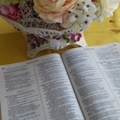[This is one in a series of devotional reflections prepared for Horley Baptist Church during September 2023]
Last week an event of astronomical importance took place, something out of this world yet something which, I suspect, went unnoticed by most people. Thinking of ‘astronomical’ in its literal sense should provide a clue.
Like many wealthy American pensioners, the sun is moving south for the winter. In the US this is called ‘snowbirding’, in the case of the sun it is part of the celestial cycle. The sun passed directly overhead the earth’s equator marking an event known as the autumnal equinox. A similar event occurs in March each year as the sun crosses the equator on its northbound movement.
For those who have forgotten their Latin, equinox translates as ‘equal night’, a reference to the occurrence when the length of daylight hours is equal to that of the dark hours. The phenomenon is global and, this year, occurred on 23rd September.[1]
The sun was created during the fourth period of creation:
God made two great lights – the greater light to govern the day and the lesser light to govern the night. He also made the stars. God set them in the vault of the sky to give light on the earth Genesis 1 v16-17 [NIVUK]
There are two broad categories of lights. There are lights which enable us to see and there are lights which are intended to be seen, although there is considerable overlap in these two functions. A vehicle’s headlights show the way ahead; its indicators give a message to those who see them.
In the sun and the moon we see examples of these two principal types of light. The sun is not intended to be seen; indeed, trying to look at it can cause severe eye damage. Instead, it gives light to enable us to see the world around us.
The moon reflects the light of the sun, enabling us to see. It does so following a predictable, but not necessarily helpful, routine; sometimes it appears half-hearted, sometimes it disappears completely. Its moods influence the rise and fall of the tides. It sends mixed-messages; contrast the romance of the Owl and the Pussycat dancing to the light of the silvery moon with the sinister overtones of a moonlit Dartmoor resounding to the ominous cry of its infamous hound. Nevertheless, God described the moon as ‘good’.
Have you ever likened yourself to the moon? Do you have your bright and dark sides? How are you using your influence? Does your faith wax and wane? What sort of messages are you sending?
God described his creation of man and woman as ‘very good’ but they lost the right to be described as such once they broke the rules that God had stipulated. The Psalmist questioned why God would still persist with them:
When I behold Your heavens, the work of Your fingers, the moon and the stars, which You have set in place; what is man that You are mindful of him, or the son of man that You care for him? Psalm 8 v3-4 [BSB][2]
God still loves his creation and he has provided a means whereby the relationship can be restored. Those who have accepted God’s offer of restoration can move from living in the dark to living in the light; furthermore, they can look forward to acquiring their own heavenly body.
The moon reflects the light of the sun – are you reflecting the light of the Son?
Resources:
[1] Equinox, via wikipedia
[2] Berean Standard Bible, via Biblehub
Bible quotations: Unless otherwise specified, quotations are taken from the resources of Bible Gateway or Bible Hub, in accordance with the licencing conditions outlined on our Site Policies page.
Bible dates:
Where appropriate, the dates given for Biblical events are based on the Bible Timeline resource
and are subject to the constraints defined on the corresponding webpage.
 Horley Baptist Church online
Horley Baptist Church onlineHBC main site
Confidential prayer link
Link to Recent Reflections
Link to Index of Bible Passages
Last week’s reflection: Were You There?
Contributed by Steve Humphreys; © Steve Humphreys
